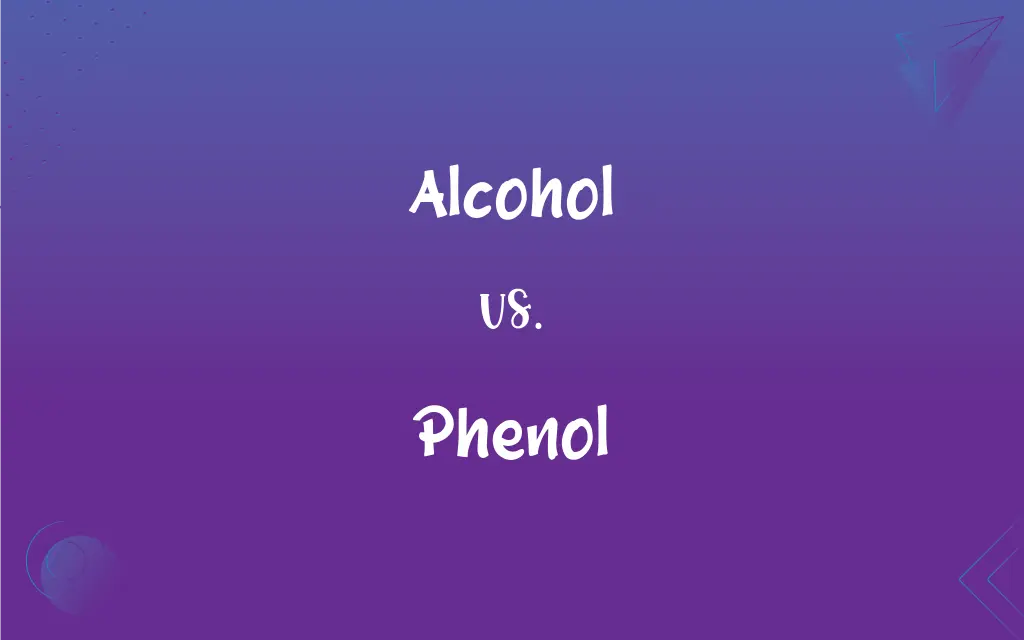Alcohol vs. Phenol: What's the Difference?
Edited by Aimie Carlson || By Harlon Moss || Published on January 15, 2024
Alcohol is an organic compound with a hydroxyl group (-OH) attached to a saturated carbon atom, widely used in beverages and industry; phenol is an aromatic compound with a hydroxyl group directly bonded to a benzene ring, important in pharmaceuticals.

Key Differences
Alcohol contains a hydroxyl group (-OH) attached to a saturated carbon atom, making it a versatile solvent and reactant in organic chemistry. Phenol, however, has the hydroxyl group directly bonded to an aromatic benzene ring, giving it unique chemical properties like higher acidity.
Alcohols are characterized by varying boiling points and solubility in water, influenced by their molecular size. Phenol, in contrast, is distinguishable by its higher boiling point due to the aromatic ring and exhibits a slightly sweet, tar-like odor.
Alcohols serve a broad range of purposes, from being key in beverages and antiseptics to fuel. Phenols are crucial in the manufacture of plastics, drugs, and dyes, underlining their importance in industrial chemistry.
Many alcohols are safe for consumption in moderate amounts, excessive use can be toxic. Phenols are generally toxic and can cause severe burns and systemic toxicity, emphasizing the need for careful handling.
Alcohols can be transformed into a variety of derivatives like ethers and esters, expanding their utility in chemical synthesis. Phenol's reactivity, particularly in electrophilic aromatic substitution, makes it a precursor to numerous complex organic compounds.
ADVERTISEMENT
Comparison Chart
Chemical Structure
Hydroxyl group bonded to a saturated carbon
Hydroxyl group bonded to an aromatic benzene ring
Boiling Point
Varied, depending on molecular size
Generally higher due to aromatic structure
Common Uses
Beverages, solvents, antiseptics, fuel
Plastics, pharmaceuticals, resins, dyes
Toxicity
Moderate to high, depending on type and exposure
Generally high, causing burns and systemic effects
Derivatives
Ethers, esters, and more
Complex organic compounds, including polymers
ADVERTISEMENT
Alcohol and Phenol Definitions
Alcohol
In chemistry, alcohol refers to a group of organic compounds with a hydroxyl group.
Ethanol is a type of alcohol used in hand sanitizers.
Phenol
In organic chemistry, phenol refers to a hydroxyl group bonded to a benzene ring.
Phenol is the simplest of the phenolic compounds.
Alcohol
Alcohol serves as an antiseptic and disinfectant in medical settings.
Rubbing alcohol is applied to wounds to prevent infection.
Phenol
It's used in the production of plastics and synthetic fibers.
Bakelite, a type of plastic, is made using phenol.
Alcohol
As a solvent, alcohol is used in a variety of industrial and laboratory processes.
Isopropyl alcohol is used to clean electronic components.
Phenol
Phenol is a precursor in the synthesis of pharmaceuticals.
Aspirin is synthesized using phenol as a starting material.
Alcohol
In fuels, alcohol can be a clean-burning, renewable additive.
Ethanol is blended with gasoline to reduce emissions.
Phenol
Phenol is a toxic, aromatic compound with antiseptic properties.
Phenol was once widely used as a surgical antiseptic.
Alcohol
Alcohol is a volatile, flammable liquid commonly used in beverages.
The wine contains 12% alcohol.
Phenol
It's also a key ingredient in the manufacture of dyes and resins.
Phenol-formaldehyde resins are used in adhesives and coatings.
Alcohol
Any of a series of hydroxyl compounds, the simplest of which are derived from saturated hydrocarbons, have the general formula CnH2n+1OH, and include ethanol and methanol.
Phenol
A caustic, poisonous, white crystalline compound, C6H6O, derived from benzene and used in resins, plastics, and pharmaceuticals and in dilute form as a disinfectant. Also called carbolic acid.
Alcohol
A colorless volatile flammable liquid, C2H5OH, synthesized or obtained by fermentation of sugars and starches and widely used, either pure or denatured, as a solvent and in drugs, cleaning solutions, explosives, and intoxicating beverages. Also called ethanol, ethyl alcohol, grain alcohol.
Phenol
Any of a class of aromatic organic compounds having at least one hydroxyl group attached directly to the benzene ring.
Phenol
A caustic, poisonous, white crystalline compound, C6H5OH, derived from benzene and used in resins, plastics, and pharmaceuticals and in dilute form as a disinfectant and antiseptic; once called carbolic acid
Phenol
Any of a class of aromatic organic compounds having at least one hydroxyl group attached directly to the benzene ring (or other aromatic ring)
Phenol
A white or pinkish crystalline substance, C6H5OH, produced by the destructive distillation of many organic bodies, as wood, coal, etc., and obtained from the heavy oil from coal tar.
Phenol
Any one of the series of hydroxyl derivatives of which phenol proper is the type.
Phenol
Any of a class of weakly acidic organic compounds; molecule contains one or more hydroxyl groups
Phenol
A toxic white soluble crystalline acidic derivative of benzene; used in manufacturing and as a disinfectant and antiseptic; poisonous if taken internally
FAQs
Can alcohol be used as a fuel?
Yes, certain alcohols like ethanol are used as biofuels.
What is alcohol?
Alcohol is an organic compound with one or more hydroxyl (-OH) groups attached to a carbon atom.
Can alcohol be synthesized chemically?
Yes, alcohol can be synthesized through fermentation or chemical processes.
Is phenol used in cosmetics?
Phenol is sometimes used in small quantities in certain cosmetic products.
What is phenol?
Phenol is an aromatic organic compound with a hydroxyl group attached to a benzene ring.
Does alcohol have medical uses?
Yes, alcohol is used as an antiseptic and disinfectant.
Why is phenol considered toxic?
Phenol can cause burns and systemic toxicity due to its chemical properties.
Are all alcohols safe to drink?
No, only specific alcohols like ethanol are safe in moderation; others are toxic.
Is phenol found in nature?
Yes, phenol occurs naturally in some plants and microbial products.
What are the effects of alcohol on the human body?
Alcohol affects the nervous system and can lead to intoxication and long-term health issues.
What is the difference in chemical reactivity between alcohol and phenol?
Phenol is more acidic and reactive towards electrophiles compared to alcohol.
How is phenol disposed of safely?
Phenol waste requires careful handling and disposal due to its toxic nature.
What are phenolic compounds?
Phenolic compounds are a large group of chemicals derived from phenol.
How is alcohol regulated?
Alcohol is regulated by laws regarding its production, sale, and consumption.
Are there any health benefits to consuming alcohol?
Moderate consumption of certain alcohols like red wine may have health benefits, though this is subject to individual health factors.
What are the industrial uses of phenol?
Phenol is used in making plastics, pharmaceuticals, and resins.
Can alcohol be used in cleaning?
Yes, alcohol is an effective solvent and cleaner for various surfaces.
What are the environmental impacts of phenol?
Phenol can be harmful to aquatic life and requires careful environmental management.
Are there natural sources of alcohol?
Yes, alcohol is produced naturally through fermentation by yeast.
Can phenol be used in food products?
Phenol is generally not used in food due to its toxicity.
About Author
Written by
Harlon MossHarlon is a seasoned quality moderator and accomplished content writer for Difference Wiki. An alumnus of the prestigious University of California, he earned his degree in Computer Science. Leveraging his academic background, Harlon brings a meticulous and informed perspective to his work, ensuring content accuracy and excellence.
Edited by
Aimie CarlsonAimie Carlson, holding a master's degree in English literature, is a fervent English language enthusiast. She lends her writing talents to Difference Wiki, a prominent website that specializes in comparisons, offering readers insightful analyses that both captivate and inform.






































































